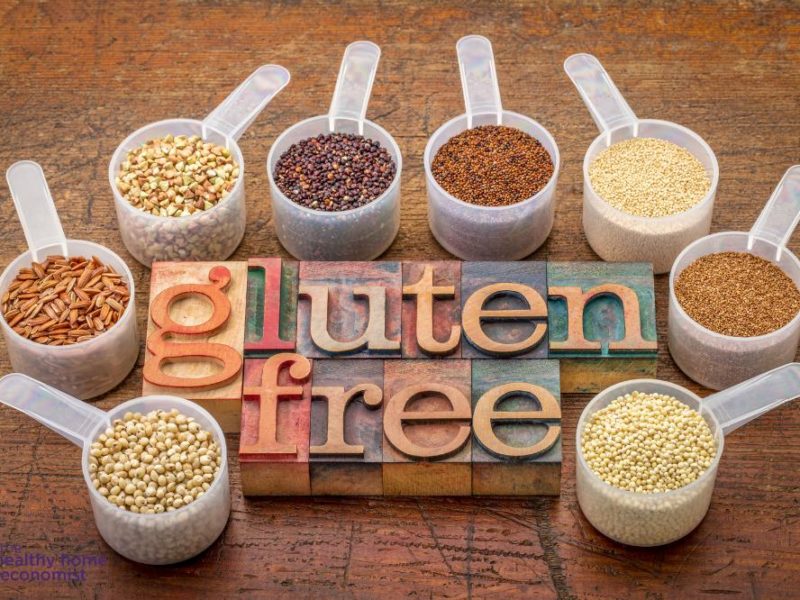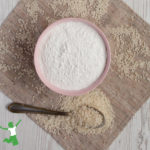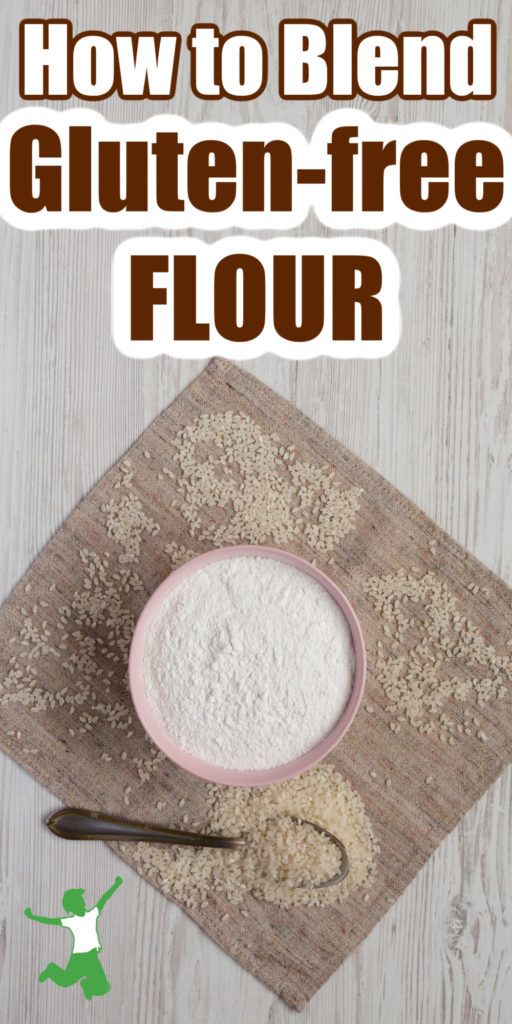Table of Contents[Hide][Show]
The complete guide on homemade gluten-free flour, with detailed instructions on how to mix and use the many different types and easy recipes to bake and enjoy.

A growing number of people are having problems tolerating gluten, a complex and difficult to digest plant protein. If you find this hard to believe, check out your local health food store. An entire aisle in one in my community is devoted to products made with gluten-free flour! A growing number of people are also interested in learning how to make gluten-free flour.
For some, the issues with gluten result from a genetic predisposition that can lead to Celiac disease, an autoimmune disorder where the consumption of gluten leads to damage to the small intestine. Celiac is estimated to affect 1 in 100 people worldwide, according to the Celiac Disease Foundation.
Gluten Sensitivity is Widespread
For millions of others, up to 15% of the population who don’t qualify as Celiacs, gluten is simply not well tolerated digestively. A wide variety of symptoms are attributed to gluten intolerance including brain fog, depression, ADHD-like behavior, abdominal pain, bloating, diarrhea, constipation, headaches, bone or joint pain, and chronic fatigue.
The widespread nature of Celiac and gluten sensitivity makes it highly probable that you will have a friend or relative with this condition come to dinner or a party at your home at some point in the future if it hasn’t happened already!
As a result, I consider baking with homemade gluten-free flour to be an essential skill in order to accommodate these folks without any loss of enjoyment for the guests who are able to tolerate wheat.
Successful gluten-free baking tastes as yummy to those who eat wheat as it does to those who don’t!
I guarantee that if you learn to bake with gluten-free flour, your baked goods will be a big hit at school and community events. More people are gluten-free than you might think!
If you would like to learn to bake gluten-free to provide options for your gluten intolerant or Celiac friends and family or to just mix it up in your own home once in a while to give everyone a break from wheat (most people eat far too much!), below is a simple guide for mixing all-purpose gluten-free flour that you can use as an easy substitute for your wheat-based recipes.
Mixing Homemade Gluten-Free Flour as a Substitute for Wheat
The problem with gluten-free baking is that the gluten itself is the very ingredient that holds moisture and binds everything together.
Gluten is food glue, so to speak.
No wonder food manufacturers love it so much and even add additional vital wheat gluten to some products to make them especially sturdy and non-crumbly. Mass production of cookies, crackers, and other processed carbs is a much more difficult process when the gluten is removed.
This is why a simple substitution of wheat with a gluten-free flour doesn’t work very well. Things fall apart and just don’t have the right consistency.
According to Becky Mauldin ND, author of Recipes for Life, the best results using gluten-free flour as a substitute for wheat flour are obtained by using at least two gluten-free flours blended together as it gives a better texture and flavor.
Gluten-free flours can be categorized into crumbly flours or binding flours. Your gluten-free flour mix of choice should include a crumbly flour (2 is better) and a small amount of one or two binding flours.
Of course, you can buy an all-purpose gluten-free flour mix from the store, but the flour will be essentially nutritionless. It is always best to grind fresh and blend gluten-free flour yourself as much as possible just the same as if you were using wheat. Here is an overview of the many choices available to you.
Crumbly Gluten-Free Flours
These flours do not hold together very well when baked. They are best blended with one or more binding flours rather than used alone or in combination with each other.
- Rice – The best choice when first attempting to bake with gluten-free flour. White rice flour is more easily digested and less allergenic than brown rice flour. Always get good quality to avoid rice heavy metal contamination.
- Amaranth – Always needs a binding flour with it. Good for cakes, cookies, and pancakes.
- Plantain or Banana – High in beneficial resistant starch and good for those who are also grain-free.
- Teff – Has a delicious, mildly nutty flavor and easy to digest. Teff is wonderful for bread, pancakes, and waffles. Not all grain grinders can handle teff as the grains are so tiny (smaller than chia seeds).
- Quinoa – Harder to digest than other gluten-free flours unless thoroughly soaked and cooked first.
- Oats – Mild tasting and makes great bread.
- Coconut – Easily make your own coconut flour with desiccated coconut pulsed in a food processor. It is typically used alone with eggs as the binding agent (see below).
- Nuts and Seeds– A good choice if using soaked nuts or seeds, else the high level of anti-nutrients makes them very hard to digest.
- Corn – Make sure to buy organic as most nonorganic corn is genetically modified. Avoid highly refined cornstarch and stick with whole-grain forms.
- Millet – Use no more than 1/5 of the total flour mix as using more tends to produce a very dry baked good.
- Sorghum – Similar to millet, sorghum is best used in smaller quantities and blended with another crumbly gluten-free flour like rice or teff.
Binding Gluten-Free Flours
These flours bind together reasonably well and don’t crumble easily when baked.
- Arrowroot – The best choice of the binding flours. Easy to digest, unrefined, and the most nutritious (where to find).
- Buckwheat – Use very small amounts as it has a very strong flavor. Best to always grind fresh as store-bought buckwheat flour tends to be bitter.
- Tapioca – Good in small quantities, good for coating anything to be fried. Imparts a chewier texture. Cassava is its more unprocessed form and is more nutritious.
- Acorn – Acorn flour naturally contains a gluten-like binder when made from acorns that were soaked instead of boiled to remove the bitter tannins.
- Potato – Highly refined and low in nutrients. Arrowroot is a healthier choice. Potato starch is better than the flour as it is high in beneficial resistant starch.
- Legume (pea, lentil, gram flour) – Beware, as anti-nutrients make these flours particularly hard to digest.
- Skip the soy flour – You don’t need the hormone disruption in your life! Beware as many gluten-free products in the store contain it (scientific evidence soy is bad for hormones).
Binder Options
Once you’ve blended your crumbly and binding gluten-free flours together, you must select a binding agent to hold everything together in the absence of gluten doing the job.
- Egg – The most nutritious binder of all. May be used in addition to xanthan gum for extra firmness.
- Flax gel (egg substitute) – Check out my recipe plus video how-to on making an egg substitute. Use 4 Tbl of the gel as the substitute for 1 egg. Tip: for extra lightness, Ms. Mauldin suggests whipping the gel and folding through the batter at the end of mixing. Do not use aquafaba made from chickpea water as it is loaded with anti-nutrients and dangerous to gut health.
- Chia seed gel – Similar to flax gel, use 4 Tbl of the chia seed gel as a substitute for 1 egg. Fold into the batter at the end of mixing as described above.
- Guar gum – Some people with sensitive digestion react to this so probably best to avoid unless absolutely necessary.
- Xanthan – Not as good as guar gum, but most people tolerate it quite well. Just be sure to source organic or nonGMO as it is usually made from fermented corn sugar. It can be made from wheat as well, so make sure it is guaranteed gluten-free (where to find).
Do not use psyllium as it encourages candida growth.
Homemade All-Purpose Gluten-Free Flour
Below are several recipes for a homemade gluten-free flour that are slightly adjusted depending on the type of baked good. Let’s begin with a recipe for all-purpose gluten-free flour.

All-Purpose Gluten-Free Flour Recipe
Easy recipe for mixing a basic gluten free flour as a baking substitute for all purpose flour or whole wheat flour.
Ingredients
- 3/4 cup rice flour remember that white rice flour is easier to digest.
- 3 Tbl arrowroot flour
- 1 Tbl tapioca starch
- 1/2 tsp xanthan gum
Instructions
-
If a given recipe calls for 1 cup of wheat flour, substitute with this all-purpose gluten-free flour mix above maintaining roughly the same proportions if you need more flour.
-
This gluten-free flour blend can be used as a quick and easy substitute for wheat flour in just about any recipe!
Whole Grain GF Bread Flour Recipe
Please note that while this combination for whole grain bread flour contains some added starch, it is in the form of plantain flour (or tapioca starch if preferred), both of which are healthy forms of resistant starch for the gut. This recipe for gluten free banana bread is a good one to try with this blend.
Substitute the following proportions for each cup of wheat flour:
- 5 Tbl sorghum flour
- 4.5 Tbl plantain flour, banana flour or tapioca starch (where to find)
- 3 Tbl teff flour
- 2 Tbl millet or quinoa flour
- 1.5 Tbl brown rice flour
- 1/2 tsp xanthan gum (where to find)
Cake Flour Recipe
This combination of gluten-free cake flour works well for making a delicious gluten-free pound cake. Instead of 2 cups of wheat flour use:
- 1 1/4 cup white rice flour
- 1/2 cup sorghum flour
- 1/4 cup arrowroot flour (where to find).
- 1 tsp xanthan gum (where to find)
Sift 2 tsp baking powder and 1/4 tsp sea salt with this gluten-free flour mix and then blend in 1 cup melted butter beaten with 1 cup sucanat, 4 eggs, plus 2 tsp vanilla and you have your batter for gluten-free pound cake!
Muffin Flour Recipe
For muffins, try this gluten-free flour mix instead of 2 cups wheat flour. Adjust proportionally for more or less flour:
- 1 1/4 cups brown or white rice flour
- 1/4 cup sorghum or millet flour
- 1/2 cup arrowroot flour (where to find)
- 1 tsp xanthan gum (where to find)
The best way to figure out what combination of gluten-free flours you like best is to experiment! Hopefully, these guidelines plus the DIY gluten-free flour substitutions suggested above depending on the baked good you are making get you well on your way to years of successful gluten-free baking.
More Options Using GF Flour
Looking for some healthy recipes to use your homemade flour? Try these:
- Gluten-free pizza crust recipe
- Old fashioned peanut butter cookies
- Pumpkin cookies
- Gluten-free waffle recipe

References
Going Gluten-Free by Becky Mauldin ND
More Information
The Real Reason Wheat is Toxic (It’s Not the Gluten)
The Good Gluten You Can Probably Eat Just Fine
The Dirty Little Secret About Gluten-Free
What? White Rice Better than Brown?








All of this gluten trouble began in 2005 when the
U.S. government OKed Roundup for dessicating wheat and other crops before harvest. See 20minute video by Dr Thierry Vrain of Trent University in Peterborough, Ontario. This video can be found in the newsletter on dirtdoctor.com.
So happy to read this! I have been gluten free for over a year and grain free mostly since last September. I’ve never been much of a baker, but perhaps I will give it a try. Thanks for the wonderful info as always, Sarah!
Susie
Hi Susie! Thanks for chiming in 🙂 Been so long since we’ve seen each other!
I don’t believe It’s the gluten that causes problems, it’s the fact that the wheat has been genetically altered. My husband exhibited signs of gluten intolerance for years and we ordered some Einkorn Wheat (Ancient wheat used in the bible times). He can eat this wheat without any problems and it has gluten in it just like all wheat, but does not bother his stomach in the least. It is so much easier than mixing all these different types of flours to come up with something that actually tastes good. It can be purchased at Jovial Foods online and delivered to your door.
The Roundup in the food system has changed the gut so that it cannot process the gluten. Also, celiac has three modes of destruction: the gut symptoms, the osteoporosis causing mode, and the seems to be no symptoms at all but silent damage to nerves. See above comment about video by Dr Thierry Vrain which is new the middle of April 2015.
Our family went GF/CF for 3 months to see if we have any sensitivities (we don’t, even upon reintroduction). I found traditional GF baked goods to be both unpalatable and a nutritional nightmare, so I started working exclusively with coconut flour. Coconut flour baking also requires lots of eggs, which ups the nutritional content and the satiety factor. To this day, my favourite cake is still Spunky Coconut’s Vanilla Bean cake. For those just starting out on GF, I’d recommend skipping right over mixing and matching GF grains and head to the Paleo websites for recipes. Some of my favourites are spunkycoconut.com, elanaspantry.com, and freecoconutrecipes.com/gluten-free-coconut-flour-recipes/. I use nuts sparingly due to the high PUFAs (marksdailyapple.com/healthy-oils/), but agree with much of their other stuff. Try coconut flour—you may just love it!
I do question the arsenic in the rice flour…
Get organic or enviro-grown in the USA and this is not a problem! The truth is that rice is fine .. you just have to seek out a clean growing environment.
Xanthan gum is from corn and is often GM.
Would you please share your gluten free chocolate chip recipe
Sarah,
What is your feeling about having small amounts of sourdough bread using Einkorn wheat berries that have been soaked and dried and ground to make the loaves ? I’m currently G F but would like to try that type of bread baking to see if I can tolerate it.
I think many gluten free folks would be delighted to find that they can tolerate einkorn prepared traditionally quite well. I don’t eat conventional wheat anymore, but regularly eat einkorn at home with absolutely no issues.
Hey Sarah,
Is it okay to use Xanthan gum? Whenever I see that ingredient or guar gum on a label, I put that food down in the store and move on. I didn’t think it was considered to be a real food? I’d like to hear your thoughts on this and any research you’ve come across too.
Thanks!
Guar gum does bother some people, but many tolerate xanthan gum fine. I don’t have a problem with it.
Thank you for the easy to understand article and instructions. When I was beginning my gf lifestyle, I would have happily paid good money for advice like this. I’ve found through trial and error that the best gf flour mixes have the most ingredients. The more varieties of crumbly and binding flours I mix together, the better the flour works. I’ve also discovered that I despise rice flour which seems to be the most popular choice. It has such an overwhelmingly strong flavor and unpleasant texture to me. I never use white rice flour and rarely use brown rice flour. I used to use xanthan gum, but found the texture of my baked goods was exactly the same, sometimes slightly better, without it. Lately, I’ve been experimenting with “gelatin eggs” as a binder in my gf baked goods.
Thanks for the input based on your GF baking experience. Can you elaborate on your use of gelatin eggs? How do you make and use them?
I’m allergic to eggs, and don’t tolerate seeds very well, so gelatin “eggs” have been a real lifesaver for my gluten free baking. I follow these instructions here: deliciousobsessions.com/2014/08/gelatin-egg-replacement/.
Have you ever tried the flax gel as an egg replacement?
Jmr, could you give us a gluten free flour recipe that you get good results?